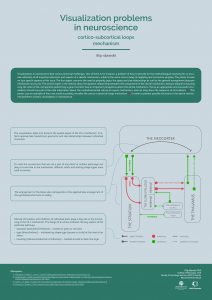Avant, Vol. XIII, No. 3, https://doi.org/10.26913/avant.3202216
published under license CC BY-NC-ND 3.0
Filip Stawski ![]()
Institute of Philosophy
Kazimierz Wielki University in Bydgoszcz
filip.stawski@ukw.edu.pl
Received 29 October 2022; accepted 16 December 2022; published 31 December 2022*
Download full text
Abstract: The aim of this paper and poster is to discuss some of the problems occurring in attempts to visualize neurobiological mechanisms. According to the thesis, neurobiological, static schemas should not only depict the order of connections among individual neural structures accordingly, but they have also the potential to present more detailed information about relations within mechanisms, such as patterns of dynamic interactions, their intensity, arrangement and the size of specific components, etc. First I will introduce the problems of visualization in neuroscience, then I am going to discuss these problems with an example of the cortico-subcortical loops (C-SL) mechanism. Finally, I will show my solutions to some visualization problems and discuss the original schemas presented in the poster.
Keywords: visualization in neuroscience; cortico-subcortical loops; philosophy of neuroscience; mechanistic explanation; cognitive processes
Bibliography
| Alexander, G. and Crutcher, M. D. (1990). Functional architecture of basal ganglia circuits: neural substrates of parallel processing. Trends in Neurosciences, 13(7), 266-271. https://doi.org/10.1016/0166-2236(90)90107-L |
| Alexander, G., DeLong, M. and Strick, P. L. (1986). Parallel Organization of Functionally Segregated Circuits Linking Basal Ganglia and Cortex. Annual Review of Neuroscience, 9(1), 357-381. https://doi.org/10.1146/annurev.ne.09.030186.002041 |
| Bechtel, W. and Richardson, R. C. (2010). Discovering complexity: decomposition and localization as strategies in scientific research. MIT Press. https://doi.org/10.7551/mitpress/8328.001.0001 |
| Boone, W. and Piccinini, G. (2016). The cognitive neuroscience revolution. Synthese, 193(5), 1509-1534. https://doi.org/10.1007/s11229-015-0783-4 |
| Craver, C. (2007). Explaining the brain: Mechanisms and the Mosaic Unity of Neuroscience. Oxford: Clarendon Press. https://doi.org/10.1093/acprof:oso/9780199299317.001.0001 |
| Crick, F. and Koch, C. (2005). What is the function of the claustrum? Philosophical Transactions of the Royal Society B: Biological Sciences, 360(1458), 1271. https://doi.org/10.1098/rstb.2005.1661 |
| Crittenden, J. R. and Graybiel, A. M. (2011). Basal Ganglia Disorders Associated with Imbalances in the Striatal Striosome and Matrix Compartments. Frontiers in Neuroanatomy, 5, 59. https://doi.org/10.3389/fnana.2011.00059 |
| Felten, D. L. and Shetty, A. N. (2012). Atlas neuroanatomii i neurofizjologii Nettera. Wrocław: Elsevier Urban & Partner. |
| Gallagher, S. (2005). How the Body Shapes the Mind. Oxford: Oxford University Press. https://doi.org/10.1093/0199271941.001.0001 |
| Gorzelańczyk, E. J. (2011). Functional Anatomy, Physiology and Clinical Aspects of Basal Ganglia, In: Peres, J. (ed.) Neuroimaging for Clinicians – Combining Research and Practice. InTech. |
| Graybiel, A. M. (1997). The basal ganglia and cognitive pattern generators. Schizophrenia Bulletin, 23(3), 459-469. https://doi.org/10.1093/schbul/23.3.459 |
| Graybiel, A. M. and Mink, J. (2009). The Basal Ganglia and Cognition In: Gazzaniga, M. (ed.) The Cognitive Neurosciences (565-586). Cambridge: MIT Press. https://doi.org/10.7551/mitpress/8029.003.0051 |
| Hanssen, H., Steinhardt, J., Münchau, A., Al-Zubaidi, A., Tzvi, E., Heldmann, M., Schramm, P., Neumann, A., Rasche, D., Saryyeva, A., Voges, J., Galazky, I., Büntjen, L., Heinze, H. J., Krauss, J. K., Tronnier, V., Münte, T. F. and Brüggemann, N. (2019). Cerebello-striatal interaction mediates effects of subthalamic nucleus deep brain stimulation in Parkinson’s disease. Parkinsonism and Related Disorders, 67, 99-104. https://doi.org/10.1016/j.parkreldis.2019.09.003 |
| Jaśkowski, P. (2009). Neuronauka poznawcza, jak mózg tworzy umysł? Warszawa: Vizja Press & IT. |
| Leisman, G., Braun-Benjamin, O. and Melillo, R. (2014). Cognitive-motor interactions of the basal ganglia in development. Frontiers in Systems Neuroscience, 8. https://doi.org/10.3389/fnsys.2014.00016 |
| Machamer, P., Darden, L. and Craver, C. (2000). Thinking about Mechanisms. Philosophy of Science, 67(1), 1-25. https://doi.org/10.1086/392759 |
| Middleton, F. and Strick, P. (2000). Basal ganglia and cerebellar loops: motor and cognitive circuits. Brain Research Reviews, 31(2-3), 236-250. https://doi.org/10.1016/S0165-0173(99)00040-5 |
| Milardi, D., Quartarone, A., Bramanti, A., Anastasi, G., Bertino, S., Basile, G. A., Buonasera, P., Pilone, G., Celeste, G., Rizzo, G., Bruschetta, D. and Cacciola, A. (2019). The Cortico-Basal Ganglia-Cerebellar Network: Past, Present and Future Perspectives. Frontiers in Systems Neuroscience, 13(61). https://doi.org/10.3389/fnsys.2019.00061 |
| Miłkowski, M., Hohol, M. and Nowakowski, P. (2019). Mechanisms in psychology: The road towards unity? Theory & Psychology, 29(5), 567- 578. https://doi.org/10.1177/0959354319875218 |
| Mink, J. (1999). Basal ganglia In: Squire, L. et al. (eds). Fundamental Neuroscience. San Diego: Academic Press. |
| Postuma, R. B. and Dagher, A. (2006). Basal ganglia functional connectivity based on a meta-analysis of 126 positron emission tomography and functional magnetic resonance imaging publications. Cerebral Cortex, 16(10), 1508-1521. https://doi.org/10.1093/cercor/bhj088 |
| Riva, D., Taddei, M. and Bulgheroni, S. (2018). The neuropsychology of basal ganglia. European Journal of Paediatric Neurology, 22(2), 321-326. https://doi.org/10.1016/j.ejpn.2018.01.009 |
| Sabatino, M., La Grutta, V., Ferraro, G. and La Grutta, G. (1986). Relations between basal ganglia and hippocampus: Action of substantia nigra and pallidum. Revue d’Electroencephalographie et de Neurophysiologie Clinique, 16(2), 179-190. https://doi.org/10.1016/S0370-4475(86)80010-7 |

